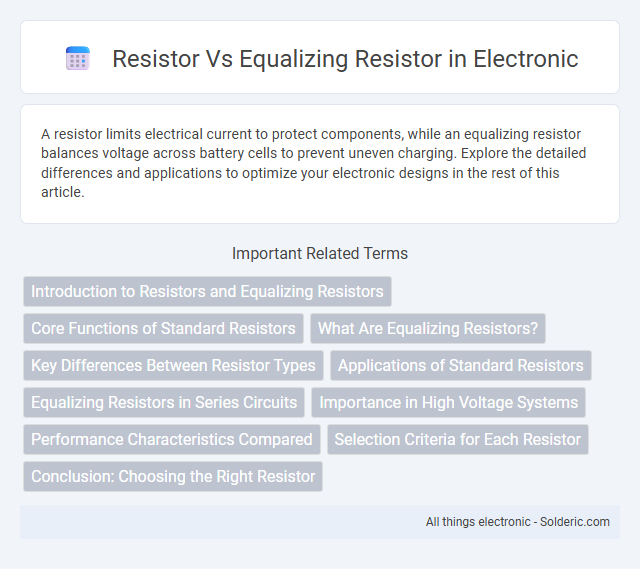A resistor limits electrical current to protect components, while an equalizing resistor balances voltage across battery cells to prevent uneven charging. Explore the detailed differences and applications to optimize your electronic designs in the rest of this article.
Comparison Table
| Feature | Resistor | Equalizing Resistor |
|---|---|---|
| Purpose | Limit current, divide voltage, and control circuit parameters. | Balance voltage across series-connected components, usually in battery packs. |
| Typical Use | General electronic circuits for current control and voltage division. | Battery management systems to ensure uniform cell voltage. |
| Power Rating | Varies widely; typically 0.125W to several watts. | Often higher power rating to handle continuous balancing currents. |
| Placement | In series or parallel within circuits. | Connected across individual battery cells in series. |
| Function | Control current/voltage, protect circuit components. | Discharge higher voltage cells to equalize voltages across cells. |
| Materials | Carbon film, metal film, wirewound. | Typically wirewound or metal oxide for stability and heat tolerance. |
Introduction to Resistors and Equalizing Resistors
Resistors control electrical current flow by providing a specific resistance value, essential for voltage regulation and circuit protection. Equalizing resistors, commonly used in series battery packs, balance voltage across cells to prevent uneven charge distribution and extend battery life. Your choice depends on whether the goal is standard current limitation or voltage equalization within battery systems.
Core Functions of Standard Resistors
Standard resistors primarily regulate electrical current and divide voltage within circuits, ensuring consistent performance and protection of components. They provide precise resistance values to control the flow of electrons, dissipating excess energy as heat to stabilize circuit operation. Unlike equalizing resistors, which balance voltage across battery cells, standard resistors focus on current limiting, signal conditioning, and maintaining desired voltage levels in various electronic applications.
What Are Equalizing Resistors?
Equalizing resistors are specialized resistors used in high-voltage battery systems and voltage divider circuits to balance voltage distribution across series-connected components, preventing voltage imbalances that could damage cells or reduce system performance. Unlike standard resistors that primarily limit current or drop voltage in circuits, equalizing resistors continuously provide a controlled current path to stabilize voltage levels across each element in a string. Understanding how equalizing resistors help maintain your battery's longevity and safety is essential for designing efficient power management systems.
Key Differences Between Resistor Types
Resistors are fundamental components that limit electric current and divide voltage in circuits, while equalizing resistors specifically balance voltage across series-connected cells or modules to prevent uneven charging. Standard resistors vary by material, tolerance, power rating, and resistance value, optimized for general purposes, whereas equalizing resistors are designed to handle higher power dissipation and maintain voltage uniformity in battery management systems. The key difference lies in their application: general resistors manage current flow broadly, whereas equalizing resistors perform precise voltage sharing to enhance battery lifespan and safety.
Applications of Standard Resistors
Standard resistors are commonly used in electronic circuits for current limiting, voltage dividing, and signal conditioning applications. Your devices rely on these resistors to maintain proper voltage levels and protect components from excessive current. They differ from equalizing resistors, which are specifically designed to balance voltage across series-connected components in high-voltage applications like battery packs or power supplies.
Equalizing Resistors in Series Circuits
Equalizing resistors in series circuits ensure voltage distribution is uniform across components, preventing imbalance and potential damage. Unlike standard resistors that primarily limit current, equalizing resistors maintain consistent voltage drops, especially in high-voltage applications like battery banks or capacitor arrays. Your circuit's reliability and lifespan improve with properly selected equalizing resistors tailored for voltage equalization tasks.
Importance in High Voltage Systems
Resistors are critical in high voltage systems for controlling current flow and voltage distribution, preventing circuit damage and ensuring operational stability. Equalizing resistors specifically balance voltage across series-connected components such as high voltage capacitors or transformers, reducing uneven voltage stresses and extending equipment lifespan. Proper selection and application of both resistor types enhance system reliability and safety by mitigating voltage surges and protecting insulation integrity.
Performance Characteristics Compared
Resistors typically provide fixed resistance values and are designed for precise current control or voltage division, ensuring stable performance in various electrical circuits. Equalizing resistors, often used in high-voltage applications such as battery banks or capacitor banks, balance voltage across components to prevent uneven stress and enhance overall durability. Your system's efficiency and lifespan improve significantly when using equalizing resistors to maintain uniform voltage distribution compared to standard resistors.
Selection Criteria for Each Resistor
Selection criteria for resistors include power rating, tolerance, and resistance value to ensure appropriate current flow and voltage drop in circuits. Equalizing resistors require precise matching and high voltage ratings to balance voltage across series components, often used in high-voltage applications like battery packs or capacitor banks. Consider thermal stability and long-term reliability for equalizing resistors, while general resistors prioritize cost-effectiveness and standard tolerance levels.
Conclusion: Choosing the Right Resistor
Selecting the right resistor depends on the specific circuit requirements, with standard resistors primarily used for limiting current and setting voltage levels, while equalizing resistors are essential for balancing voltage across series-connected components like batteries or capacitors. Equalizing resistors prevent voltage imbalance and enhance overall system reliability, especially in battery management systems and capacitor banks. Understanding the function and application of each resistor type ensures optimal performance and longevity of electronic devices.
resistor vs equalizing resistor Infographic

 solderic.com
solderic.com